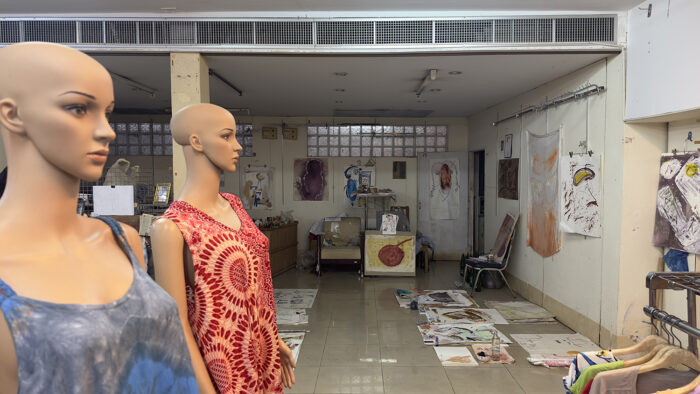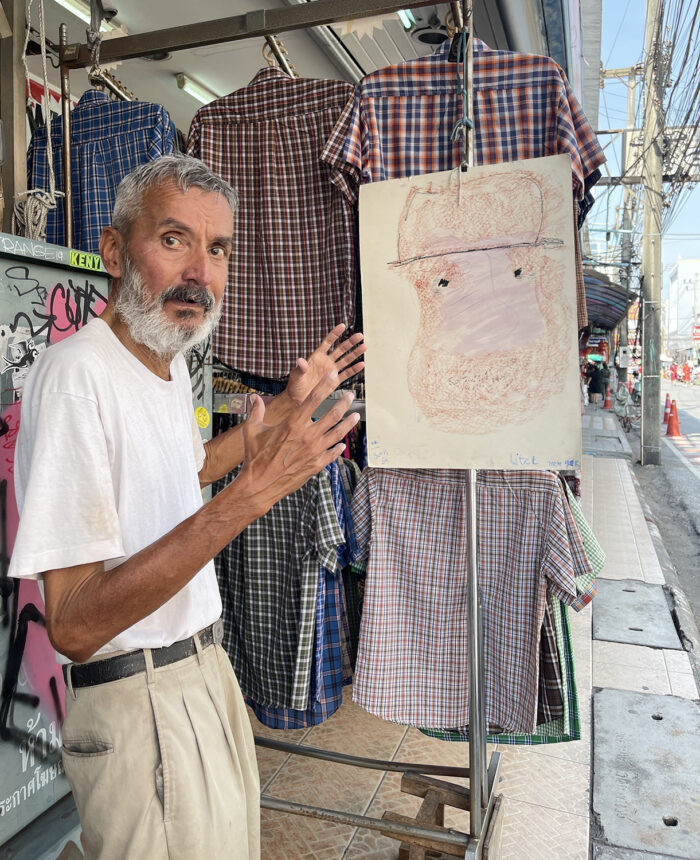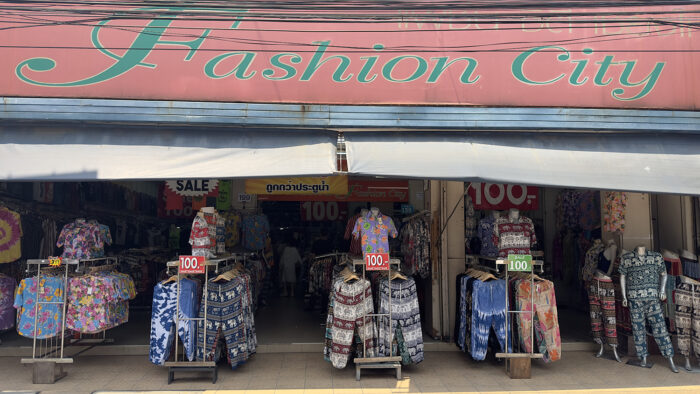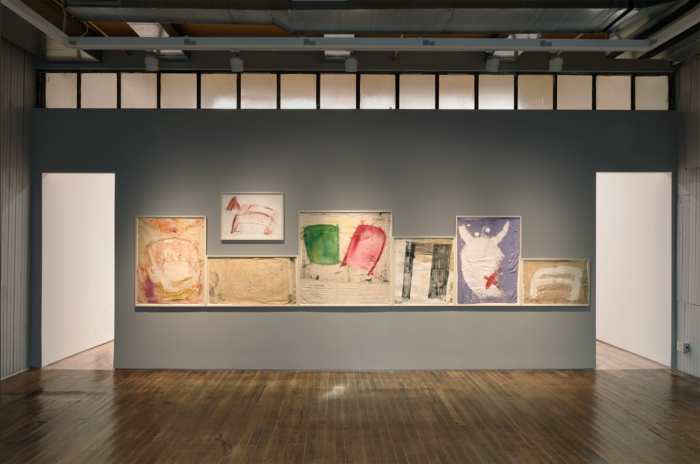
Born in 1956 of Indian descent, Piti Sedthee is a self-taught artist living and working in Thailand whose expressive creations radiate purity, honesty, freedom, and directness. Embracing painting as a medium to navigate his emotions, Piti’s works often feature faces from media headlines, family members, and scenes from his complex mind, even capturing fleeting moments like a child’s smile at Warorot Market. Rooted in the everyday and mundane, his art offers profoundly spiritual and personal interpretations of life’s realities. Piti’s studio, nestled within a clothing wholesale store in Chiang Mai’s local market, is a vibrant space where paintings on paper and packaging fabrics hang casually among plastic mannequins and scattered art supplies. Amidst pictures of Buddha statues, the old Thai king, and news clippings, his studio brims with acrylics, spray paints, dyes, and crayons.
Inspired by urban landscapes encountered during his extensive travels, Piti’s work, from London’s rainy streets to Berlin’s cityscape, is a concentrated, almost abstract exploration of the otherworldly, narrating and reimagining everyday scenes through bold colors and alternative materials. We interviewed him via email, utilizing a translator since he is not currently in New York. His recent exhibition, Piti, was held at the YveYang Gallery in Tribeca, NYC, and recently concluded. I was fortunate to attend the opening, where I was captivated by his paintings and remarkable journey from the streets of Thailand to the dazzling art scene of New York. Below, you’ll find an insightful interview about his foray into the contemporary art world.
ArteFuse: When did you start painting?
Piti Sedthee: I began learning painting techniques while attending university in Chiang Mai. Later, in 1996, my brother and I went to the UK, and it was then that I started painting seriously, using it as a way to relax. Initially, we were just doing ordinary business, selling fabrics. I followed my brother in selling fabrics, but I had a strong desire to paint, so I started painting.
AF: What was your motivation for painting?
PS: Initially, it wasn’t to become an artist or sell paintings. It was purely for the love of it. When I went to the UK, everyone saw me as an artist. There’s a saying in Thai, ศิลปินไส้แห้ง, that being an artist means being poor. Many people call me an artist but has no money. However, I never considered myself an artist; I was just an ordinary person who painted for the love of it.
AF: What happened to your artwork after your stay in the UK?
PS: Most of them were donated to local charities. On my second visit, I painted more and left the works in the UK, thinking I’d return. However, due to visa issues, I couldn’t. After a short stay in Germany, I returned to Thailand in 1997 and haven’t left since.

AF: What is your painting process like?
PS: My works look dynamic and spontaneous but are created slowly, often starting with a clear idea. Sometimes, I take breaks in between. For instance, if I want to paint Prayuth, our former Prime Minister, I’ll start by looking at his photo, preparing the paper, and painting. Sometimes, I pause, and it may be complete then, or I may revise it. The subject is always in my mind, but I don’t think while painting. I’m interested in many things, but if I have no theme today, I won’t start.
AF: Do you usually complete your paintings in one day, or do they take longer?
PS: Generally, I finish them in one day. Once completed, I don’t revisit them.
AF: Do feedback from frequent visitors or gallery owners affect your work?
PS: I don’t mind feedback; I can accept it. Once, a stranger saw my paintings and suggested I should add more detail if the paintings were larger. I didn’t take that advice because I prefer to express my own ideas and feelings in my paintings. I can listen to advice, but it’s my decision whether to act on it or not.
AF: Where have you traveled?
PS: Apart from intermittently living in the UK for two years, I’ve briefly stayed in Japan. I’ve also traveled to France, Berlin, Munich, and Vienna in Austria. I wanted to visit Düsseldorf and Hamburg in Germany but couldn’t make it.

AF: Have you ever been to New York? How did you establish your connection with the YveYANG Gallery, and what emotions are you experiencing now that you have a solo show there?
PS: I’ve never been to the US. Earlier this year, a young couple who were very fond of my paintings visited my studio. They meticulously viewed all my works and even discovered my 1990s piece “Blue Eyes” in piles of wholesale clothes. I signed all the selected pieces for them and shared the stories behind them. For example, “Blue Eyes” was inspired by a man with strikingly blue eyes I saw in the UK nearly 30 years ago. It amazed them, describing it as “the bluest lake on earth, drawing you in.” They eventually took my works to the US. I’m very grateful and happy.
After the exhibition opened, their friend in Chiang Mai brought me printed photos of the exhibition. They recreated my “sofa” scene from my studio, surrounded by beer bottles. It was thoughtful and delightful.
AF: How do you feel about having a solo exhibition in New York?
PS: It’s wonderful, although I imagine the gallery must have spent a lot to make it happen. Some people envy me; my family jokes that I’m now a famous artist. But I remain unchanged. I’m just happy that my works are reaching different parts of the world. Many visitors buy my paintings from Germany, Australia, Japan, and Singapore. I like my work to be everywhere in the world.

AF: The works on display include paintings on paper and various fabrics. Could you delve into the specific types of fabrics you use for your paintings? What is it about these fabrics that add a unique dimension to your work?
PS: Many of the canvases are donated by nearby fabric stores. If I need a large canvas, I buy it. I also use a lot of acrylic paints and sometimes dye paints to color the canvas.
AF: Can you explain the process behind the painting “Hungry Tiger” (2023) on paper?
PS: “Hungry Tiger” depicts Princess Sirindhorn of Thailand, the sister of the current King and daughter of the former King Bhumibol. The former King was a kind tiger, and each princess has her own representative color; Princess Sirindhorn’s is purple. “Hungry Tiger” signifies hard work, passion, and tirelessness. Princess Sirindhorn sees herself as a hungry tiger. I deeply respect the Thai royal family, and Princess Sirindhorn is the one I admire the most. My work reflects my everyday thoughts, transferring them onto paper or fabric. At that time, I wanted to preserve this feeling of admiration.

AF: What are you currently working on? Any plans?
PS: I have no specific plans. I come to the studio every day and think about what to paint and how to paint it. I’m always creating new works, nothing else. Sometimes, I think about what to paint the next day before I go to sleep, even if I don’t end up painting it. Occasionally, I ponder who will manage my works in the future since my family isn’t interested. I have no goals; if I had money, I’d donate it.
AF: How do you spend your day?
PS: I wake up at six, take a shower, have tea with my mom, and feed her birds. After tea, I walk to the studio, and have drinks in between. I also play small bets on football with my family, drink beer, and go home by 8 PM. Nowadays, I try to live according to Buddhist principles, which include five precepts: 1) Not killing animals, 2) Not lying, 3) Not engaging in adultery, 4) Not stealing, and 5) Not consuming intoxicants. I can adhere to all these precepts except for not drinking alcohol, which I still enjoy, haha. Apart from that, I follow the other principles diligently.


